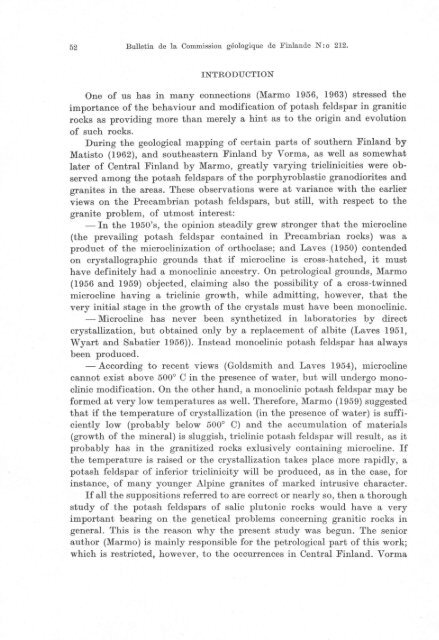COMMISSION GEOLOGIOUE - Arkisto.gsf.fi
COMMISSION GEOLOGIOUE - Arkisto.gsf.fi
COMMISSION GEOLOGIOUE - Arkisto.gsf.fi
Create successful ePaper yourself
Turn your PDF publications into a flip-book with our unique Google optimized e-Paper software.
52 Bulletin de la Commission geologique de Finlande N: 0 212.<br />
INTRODUCTION<br />
One of us has in many connections (Marmo 1956, 1963) stressed the<br />
importance of the behaviour and modi<strong>fi</strong>cation of potash feldspar in granitic<br />
rocks as providing more than merely a hint as to the origin and evolution<br />
of such rocks.<br />
During the geological mapping of certain parts of southern Finland by<br />
Matisto (1962), and southeastern Finland by Vorma, as weH as somewhat<br />
later of Central Finland by Marmo, greatly varying triclinicities were observed<br />
among the potash feldspars of the porphyroblastic granodiorites and<br />
granites in the areas. These observations were at variance with the earlier<br />
views on the Precambrian potash feldspars, but still, with respect to the<br />
granite problem, of utmost interest:<br />
- In the 1950's, the opinion steadily grew stronger that the microcline<br />
(the prevailing potash feldspar contained in Precambrian rocks) was a<br />
product of the microclinization of orthoclase; and Laves (1950) contended<br />
on crystaHographic grounds that if microcline is cross-hatched, it must<br />
have de<strong>fi</strong>nitely had a monoclinic ancestry. On petrological grounds, Marmo<br />
(1956 and 1959) objected, claiming also the possibility of a cross-twinned<br />
microcline having a triclinic growth, while admitting, however, that the<br />
very initial stage in the growth of the crystals must have been monoclinic.<br />
- Microcline has never been synthetized in laboratories by direct<br />
crystallization, but obtained only by areplacement of albite (Laves 1951,<br />
Wyart and Sabatier 1956)). Instead monoclinic potash feldspar has always<br />
been produced.<br />
- According to recent views (Goldsmith and Laves 1954), microcline<br />
cannot exist above 500 0<br />
ein the presence of water, but will undergo monoclinic<br />
modi<strong>fi</strong>cation. On the other hand, a monoclinic potash feldspar may be<br />
formed at very low temperatures as weH. Therefore, Marmo (1959) suggested<br />
that if the temperature of crystaHization (in the presence of water) is suf<strong>fi</strong>ciently<br />
low (probably below 500 0<br />
C) and the accumulation of materials<br />
(growth of the mineral) is sluggish, triclinic potash feldspar will result, as it<br />
probably has in the granitized rocks exlusively containing microcline. If<br />
the temperature is raised or the crystallization takes place more rapidly, a<br />
potash feldspar of inferior triclinicity will be produced, as in the case, for<br />
instance, of many younger Alpine granites of marked intrusive character.<br />
If aH the suppositions referred to are correct or nearly so, then a thorough<br />
study of the potash feldspars of salic plutonic rocks would have a very<br />
important bearing on the genetical problems concerning granitic rocks in<br />
general. This is the reason why the present study was begun. The senior<br />
author (Marmo) is mainly responsible for the petrological part of this work;<br />
which is restricted, however, to the occurrences in Central Finland. Vorma
















